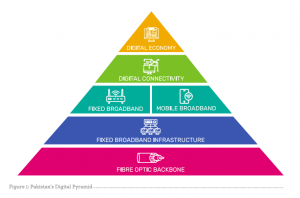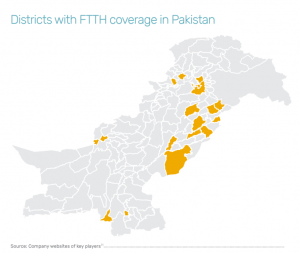You can download the full paper here.
The Internet has become a basic necessity ingrained in every aspect of daily life, whether that is in terms of communication, social media, service delivery or education. This rapid digitisation was particularly made evident during Covid-19, which highlighted the limitations and gaps in Pakistan’s connectivity landscape, characterised by high mobile broadband usage and low smartphone penetration. To optimise its digital economy and transition to 5G technology, Pakistan must expand high speed Internet connectivity by strengthening its fixed-line and fibre optic infrastructure.Why is Fixed Broadband important?

- Fixed broadband offers a faster and more reliable connection than mobile broadband
- Fixed line infrastructure powers mobile broadband by connecting cell sites to mobile switching centres over a backhaul network
- Fibre optic infrastructure can enable 5G connectivity in addition to improving 4G
- Growing data demands at an average 8 to 10 GB per user will require better broadband quality
Principles
A strong broadband landscape can power three forms of critical connectivity:
- Individual: for entertainment, service delivery, public services, employment and more
- Family: to provide instant and reliable communication between families with increasing preference for rich media use-cases
- Enterprise: to power communication, collaboration, access to data, information and knowledge, and other business-critical applications
Fibre in Pakistan
Pakistan’s fibre landscape is characterised by:
- 130,000 to 150,000 kilometres of fibre laid out in Pakistan

- 9% of cell towers are connected to fibre compared to
international benchmarks of 40% - Less than half million FTTH subscribers in a market of at least 10 million potential subscribers. This means Pakistan has only 4% FTTH penetration
A market gap of this size presents an investment opportunity of up to USD 6 billion and will require addressing the following challenges
Key Challenges
- Sub-optimal levels of investment at USD 150 to 250 million per annum
- Limited market competition and little to no sharing of infrastructure
- Unfavourable policy and regulatory environment with high fees, slow implementation, and Right-of-Way issues
Recommendations
Targeted policy interventions are required in the following priority areas:
- Raising the importance of fixed broadband by establishing broadband as a critical infrastructure
- Developing a national broadband strategy by creating a national fibre plan, reducing barriers for expedited rollout, and enhancing accountability
- Improve the investment climate and availability of financing across the digital ecosystem
- Improving administration at all tiers of the government to speed up implementation
You can download the full paper here.
[/vc_column_text][/vc_column][/vc_row]










